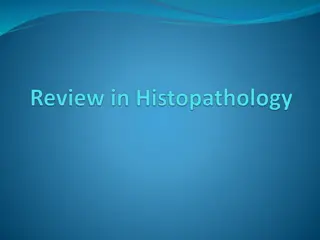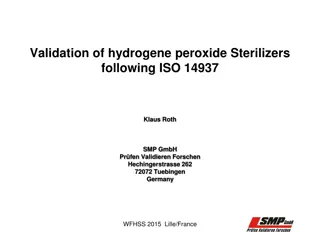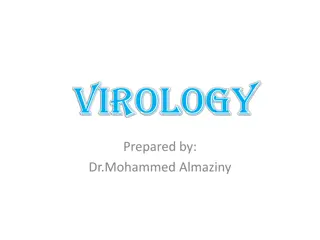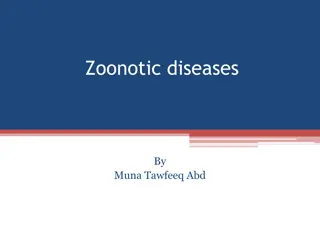PRIONS
Prions are unusual infectious agents composed of misfolded proteins that can induce catastrophic changes in the host's normal cellular proteins. Discovered in 1982 by Stanley B. Prusiner, prions have been linked to various fatal neurodegenerative diseases in animals and humans, such as scrapie, Creutzfeldt-Jakob disease, and mad cow disease. This content explores the nature of prions, their impact on brain health, different types of Transmissible Spongiform Encephalopathies (TSEs), and specific cases like Kuru in New Guinea. By delving into the world of prions, we can gain insight into the complex mechanisms underlying these unique infectious agents.
Download Presentation

Please find below an Image/Link to download the presentation.
The content on the website is provided AS IS for your information and personal use only. It may not be sold, licensed, or shared on other websites without obtaining consent from the author.If you encounter any issues during the download, it is possible that the publisher has removed the file from their server.
You are allowed to download the files provided on this website for personal or commercial use, subject to the condition that they are used lawfully. All files are the property of their respective owners.
The content on the website is provided AS IS for your information and personal use only. It may not be sold, licensed, or shared on other websites without obtaining consent from the author.
E N D
Presentation Transcript
What are PRIONS? Prions are infectious agents composed of protein in misfolded form. initially thought to be viruses which replicated slowly within their hosts, but no nucleic acid found associated with infectious material. Shown to be aberrant forms of normal cellular proteins which can induce changes in the shape of their normal homologs with catastrophic consequences for the host. Discovered by STANLEY B.PRUSNER in 1982 and got Nobel Prize in 1998 for this contribution.
Normal form of protein called PrPc , while the infectious form is PrPSc. Here c refers to cellular or common PrP. Sc refers to Scrapie, a prion disease occuring in sheep. Structure of PrP is well defined but of PrP Sc is polydispersed and defined at a relatively poor level.
Brain Damage from Spongiform Encephalopathy vacuole Source: UC Davis School of Veterinary Medicine
Transmissible spongiform encephalopathies Animals Bovine spongiform encephalopathy (BSE) Scrapie in sheep and goats Transmissible mink encephalopathy Chronic wasting disease of deer, elk Humans Kuru Creutzfeldt-Jacob disease (CJD) Fatal familial insomnia (FFI) Gerstmann-Straussler syndrome (GSS) TSEs are always fatal
Types of TSEs Infectious e.g., kuru, BSE (mad cow disease), scrapie Spread by consumption of infected material Iatrogenic spread (organ transplant, esp. cornea) transfusion Sporadic 1-2 million infected worldwide, late in life Evidence mounting that some sporadic TSE is really result of infection Familial Due to autosomal dominant mutation of PrP Inherited at least 10-15% of total human TSE cases Each of these can be transmitted experimentally
Kuru Identified in New Guinea by Robert and Louise Glasse in 1950 s 1% of the Fore tribe was afflicted; mostly women, some children, few adult males Symptoms: headache, joint pain, 6-12 weeks later- difficulty walking and death usually within 12 months, (always within 2 years) Disease was of recent origin: ~1910-1920 Glasses suggested that endocannibalism was associated with disease
Australian government suppressed cannibalism among North Fore in early 1950 s South Fore were convinced to discontinue the practice in 1959 Incidence of kuru among North Fore ceased ~ 5 years before South Fore; no child born since then has died of kuru Carlton Gadjusek, scientist with NIH, inoculated chimps with brain extracts of kuru victims; all chimps died after 50 months No unique antibodies were associated with disease, no virus particles or aberrant nucleic acids were identified Gadjusek got Nobel Prize
Scrapie An animal model was needed to study TSEs Scrapie disease of sheep had many similarities to kuru in terms of symptomatology and etiology Could be transmitted to hamsters and mice, kuru could not Scrapie was used as first good animal model TSE 2 month incubation in rodents Infectious agent purified 5000 fold Nuclease resistant UV and heat resistant Sensitive to protease (only at high levels) & protein denaturants
Major Contributors to the History of Prions Glasses research in1950 s and 60 s Carlton Gajdusek receive Nobel Prize in 1976 for proving transmissibility of Kuru In 1982 Stanley Prusiner -concluded no NA, first named proteinaceous infectious particles that resist inactivation by procedures that modify nucleic acids as PRIONS-received Nobel Prize in 1997.
Different prions affect different parts of the brain Cerebral cortex When the cerebral cortex is affected, the symptoms include loss of memory and mental acuity, and sometimes also visual imparement (CJD). Thalamus Damage to the thalamus may result in insomnia (FFI). Cerebellum Damage to the cerebellum results in problems to coordinate body movements and difficulties to walk (kuru, GSS). Brain stem In the mad cow disease (BSE), the brain stem is affected.
Effect of prions on neural tissue Convert PrPc into PrPSc PrPc is readily digested by Protease K and can be liberated from the cell surface in vitro by enzyme phosphoinositide phospholipase (PI-PLC). Play important role in cell-cell adhesion and intracellular signalling. PrPSc has identical primary structure but different beta structures leading to resistance of protease cleavage. Brain tissue collects PrPSc causing too much protein accumulation. Distinguished by nerve cell death causing large vacuoles and plaques in brain tissue
Electron Micrographs showing : A. PrP Protein. B. PrPSc Protein. C. Prion rods composed of PrPsc. Figure 3
How do prions function? (prion hypothesis) PrPc The prion protein exists in two forms. The normal, innocuous protein (PrPc) can change its shape to a harmful, disease-causing form (PrPSc). The conversion from PrPc to PrPSc then proceeds via a chain- reaction. When enough PrPSc proteins have been made they form long filamentous aggregates that gradually damage neuronal tissue. The harmful PrPSc form is very resistant to high temperatures, UV- irradiation and strong degradative enzymes. PrPSc
PrPc PrPsc 209 amino acid long (in humans), one disulfide bond, a molecular mass of 35 36 kDa and a mainly alpha- helical structure 209 amino acid long (in humans), one disulfide bond, a molecular mass of 35 36 kDa Higher proportions of beta sheets Protease Resistance: low high Heat resistance: low high Insoluble, forms aggregates, form highly structured amyloid fibers, which accumulate to form plaques Catalyze convertion of PrPc into PrPsc Soluble: doesn t forms aggregates Normal cellular protein involved in cell- cell adhesion and intracellular signalling Role in SPEs
Prion biology For a prion (PrPSc) to infect a host, the host must have a recognizable cellular form (PrPc) of that prion Generally, the closer the phylogenetic relationship between the donor host and the recipient, the greater the chance for infection, and the more rapidly symptoms occur Level of accumulation of prion does not necessarily correspond to level of disease Mice in which PrPc copy is knocked out have altered sleep/wake cycles and circadian rhythm
Prions First identified with Spongiform encephalopathies Characteristics of infection: Loss of motor control Dementia Paralysis Encephalitis Widespread neuronal loss Mode of transmission: Infectious (including diet, after surgical procedures, corneal transplants etc.) Hereditary (autosomal and dominant mutations)
Chemical Treatment: Concentration PSTV (viroid) + + - - + - (-) - Scrapie (prion) - - + + - + + + NH2OH (hydroxylamine) Psoralen (binds NA) Phenol SDS Zn2+ Urea Alkali KSCN Enzymatic Treatment: RNAse A DNAse Proteinase K Trypsin + = inactivated; - = no change in infectivity 0.1-0.5mM 10-500 g/ml Saturated 1-10% 2mM 3-8M pH 10 1M 0.1-100 g/ml 100 g/ml 100 g/ml 100 g/ml + - - - - - + +
Bovine spongiform encephalopathy (BSE) mad cow disease In Britain in the 1970 s, hydrocarbon-solvent extraction of meat and bone meal (MBM) used for cattle feed In 1987, BSE emerged disease Epidemiology suggested a prion disease, and MBM use was abandoned BSE incubation period is ~5 years Estimated that over 1,000,000 cattle were infected In 1989, human consumption of bovine CNS tissue (thought to have the highest prion concentration) banned based on fears of transmission to humans In 1996, a new type of CJD appeared in Britain and France; young patients (<40 years old) and different neuropathology
Evidence that BSE gave rise to vCJD in humans Course of vCJD disease was 14 months rather than 4-6 month for CJD, suggesting more distantly related source Proteolytic degradation pattern suggests variant CJD (vCJD) closer to BSE than other CJD strains
Economic Impact of Mad Cow Disease 3 BSE-infected cows identified in Canada in May, 2003 BSE identified in a cow, originally from Canada, in Washington state in Dec., 2003; another in Texas in 2005 Embargoes against U.S. and Canadian beef brought immediately by most importers Loss to U.S. and Canadian beef industries so far due to embargoes: approximately $10 billion Canada and U.S. test only a small proportion (<1%) of cattle; Europe and Japan test 100% After BSE was found in Japan in 2001, U.S stopped importing Japanese beef; Japanese consumption of beef also plunged








